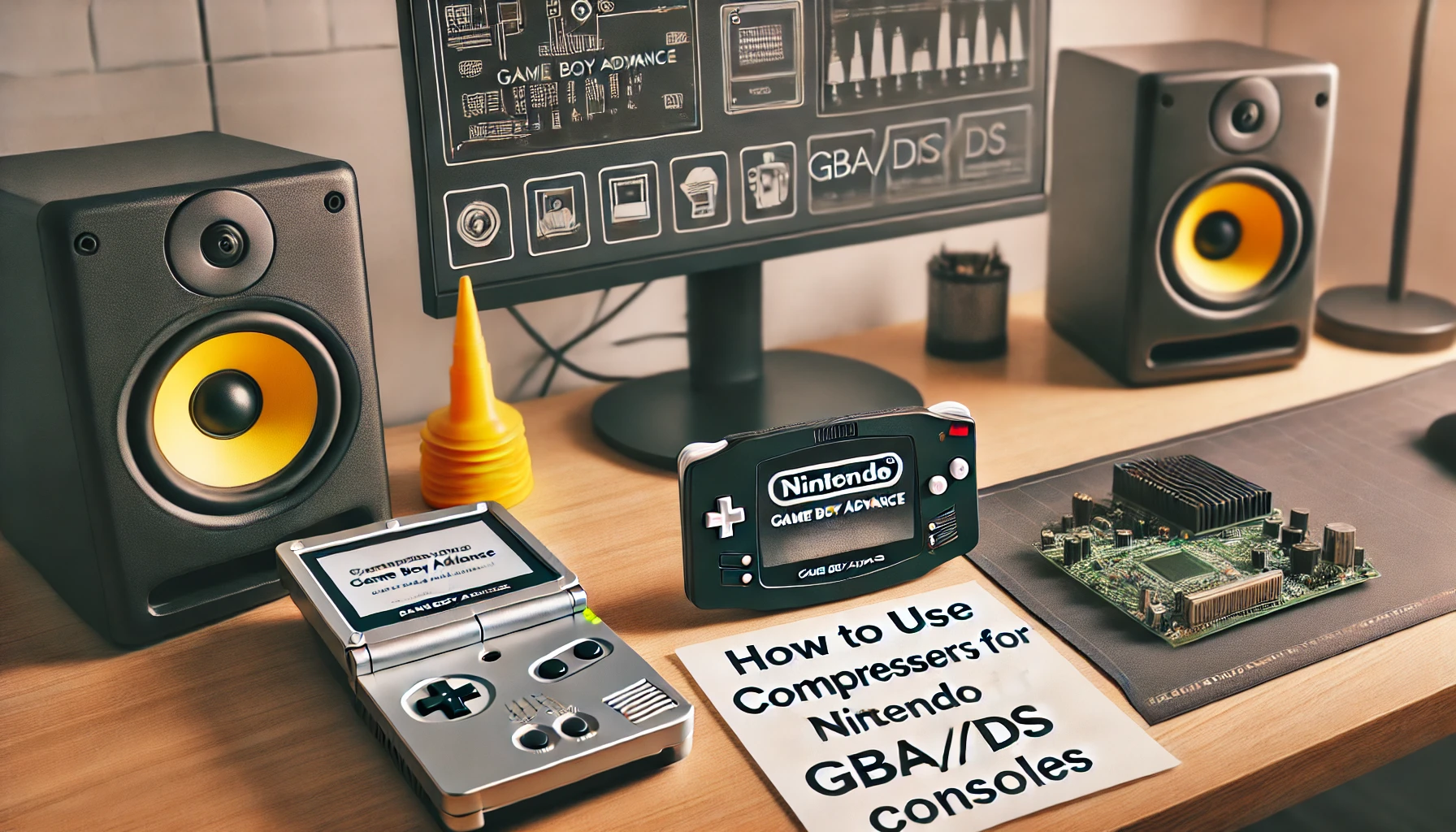Compression tools are essential for developers and enthusiasts working with how to use compressors for Nintendo GBA/DS consoles by CUE , enabling efficient use of limited storage space and faster loading times. In this detailed guide, we’ll explore how to use CUE’s compressors for these consoles, covering everything from setting up the necessary tools to advanced compression techniques.
Introduction to CUE’s Compression Tools for GBA/DS Consoles
Understanding how to effectively utilize how to use compressors for Nintendo GBA/DS consoles by CUE can significantly enhance the performance and functionality of games and applications on GBA and DS consoles. CUE’s compression utilities offer robust solutions for manipulating game data, allowing modifications and optimizations that were not possible with original game files.
Getting Started with Compression Tools
Setting Up the Tools
Before diving into compression, you need to set up your environment:
- Download Compression Software: Obtain the latest version of CUE’s compressors from a reliable source. Ensure the tools are compatible with your operating system.
- Install Supporting Software: Some compressors may require additional frameworks or libraries. Install these prerequisites as per the documentation provided with the tools.
- Prepare Your Work Environment: Set up a dedicated folder for your projects to keep your files organized and easily accessible.
Understanding Different Compression Formats in GBA and DS ROMs
GBA and DS ROMs use various compression formats to optimize storage and performance:
Before diving into the extraction process, it’s important to understand that ROM files for the GBA and DS are often compressed to save space and optimize performance. These files might use several types of compression, with LZ77 being one of the most common, alongside others like Huffman encoding or Run-Length Encoding (RLE).
- LZ77: Commonly used in Nintendo platforms, it provides good compression ratios and speed.
- Run-Length Encoding (RLE): Effective for compressing data with lots of repeated bytes.
- Huffman Encoding: Used for data that exhibits variable frequency of bytes.
Each format has its strengths and is chosen based on the data type and required compression efficiency.
Extracting Data from ROMs Using CUE Compressors
To modify game content, the first step is extracting data:
- Identify the Compression Format: Use tools to analyze the ROM and determine the compression format of the data.
- Extract the Data: Use CUE’s decompression tools to extract files from the ROM. Ensure you maintain backups of original ROMs to prevent data loss.
Modifying Previously Extracted Data
1. Understanding the Data Structure
Before you begin modifying the extracted data, it is crucial to understand the file structure and format:
- Data Types: Know whether you are dealing with graphics, sound files, text, or executable code.
- File Formats: Identify the specific formats like tile graphics (.tile), map data (.map), or text files, as each may require different tools or methods for editing.
2. Choosing the Right Tools
Selecting the appropriate tools for modification depends on the type of data:
- Graphics Editors: Use tile editors or image manipulation tools if you are modifying sprites or backgrounds.
- Text Editors: For text, a simple text editor may suffice, but for editing executable code, you might need a hex editor or a specialized software that handles game coding.
3. Making Modifications
- Back Up Original Data: Always keep a backup of the original extracted data before making changes.
- Edit Carefully: Make your desired modifications. For graphics, this could involve changing colors, reshaping characters, and for text, altering dialogues or descriptions.
- Test Frequently: After each significant change, save and test the modification to ensure it works as expected without corrupting the data.
Recompressing Data
After modification, data needs to be recompressed:
Recompressing Data with CUE Compressors
Once you’ve made your modifications, the next step is to recompress the data so it can be reinserted back into the ROM. This stage is critical to ensure the modified game runs correctly on the console.
1. Choosing the Appropriate Compression Method
- Match the Original Compression: It’s generally best to recompress the data using the same method it was originally compressed with unless a different method offers specific advantages.
- Understand Compression Limitations: Some compression methods might not be suitable if the modified data significantly differs in size from the original.
2. Using CUE Compressors for Recompression
- Prepare the Data: Ensure your modified files are ready and error-free. Confirm file sizes and formats align with the requirements of the compression tool.
- Execute the Compression Command: Use the CUE compressor through the command line or graphical interface, similar to the extraction process. For example:luaCopy code
cue-compress -input modified_data.file -output recompressed_data -format lz77Substitute “modified_data.file” with your file’s name, “recompressed_data” with the output file’s desired name, and adjust the format if necessary.
3. Validating the Recompressed Data
- Test the ROM: Load the recompressed data into the ROM and test it extensively in an emulator or on actual hardware to ensure the game operates without issues.
- Check for Errors: Be on the lookout for any anomalies or crashes, which might suggest issues in the recompression process or data corruption.
Confirming the ROM Integrity After Compression
After recompression, it’s crucial to test the ROM:
- Load the ROM into an Emulator: Check for any issues like crashes or corrupt graphics.
- Test on Actual Hardware: If possible, test the ROM on a physical console to ensure compatibility.
Handling Compression Errors
how to use compressors for Nintendo GBA/DS consoles by CUE Encountering errors during compression is common. To troubleshoot:
- Check the Format: Ensure you are using the correct compression format and settings.
- Review the Data: Errors can occur if the data is modified incorrectly. Review changes for any potential mistakes.
Advanced Techniques for Compressing Custom ROMs
For more sophisticated projects, you might need advanced compression strategies:
- Hybrid Compression: Combine different compression techniques to optimize efficiency.
- Custom Compression Algorithms: Develop custom algorithms tailored to specific data types or game mechanics.
Various Applications of Using Compressors
Compression tools are not limited to game development. They can also be used for:
- Data Analysis: Compressed data can be analyzed to understand game mechanics and resource usage.
- Educational Purposes: Learning about compression helps in understanding computer science and data management principles.
Conclusion: The Power of Efficient Compression
Mastering CUE’s compressors opens up vast possibilities for GBA and DS development and beyond. Whether you’re developing new games, modifying existing ones, or simply exploring the inner workings of game data, efficient compression is a key skill that enhances your capabilities in the digital world.
FAQ: Using CUE Compressors for Nintendo GBA/DS Consoles
What is a CUE compressor?
A CUE compressor is a tool used to compress ROM files for Nintendo GBA and DS consoles, making the files smaller and easier to manage or distribute without affecting their functionality.
Where can I download a CUE compressor?
CUE compressors can typically be found on software download sites or forums that focus on gaming and emulation. Always ensure you download from a reliable and secure source to avoid malware.
Are there any risks associated with using a CUE compressor?
Using a CUE compressor is generally safe. However, always back up your original ROM files before compression in case of any errors or data loss during the compression process.
Can I decompress a ROM back to its original state?
Yes, most CUE compressors also feature a decompression option. To decompress a ROM, simply load the compressed file into the compressor, select the decompression function, and save the restored ROM.
Will compressed ROMs still work on my emulator?
Compressed ROMs should work as normal on most emulators. However, ensure your emulator supports the specific compression format used by the CUE compressor.
Is it legal to compress ROMs using a CUE compressor?
Compressing ROMs is legal as long as you own the original game and are using the compression for personal backup purposes. Distributing compressed ROMs without permission, however, is illegal and considered piracy.


